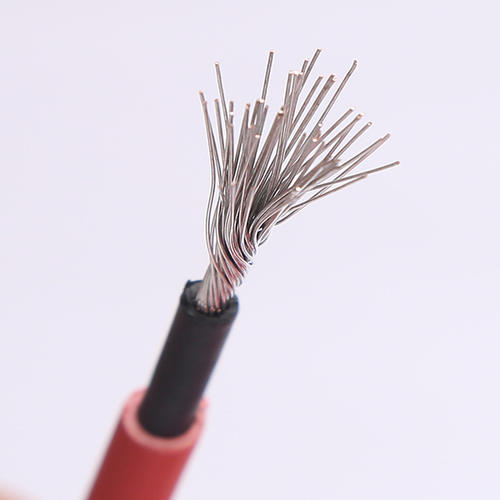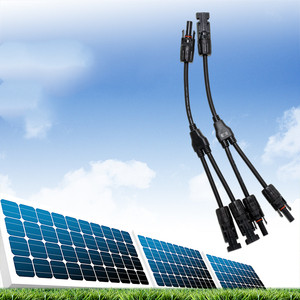The 6mm solar cable is one of the most popular choices for small solar systems and one of the easiest to connect and manage. 6mm solar cables are the larger alternative to 4mm solar cables - both of which are widely used for home solar applications. If you want to connect your photovoltaic system in a permanent manner, you're going to need a 6mm solar cable.
Note: We do not recommend connecting this cable unless you're a solar professional, and this guide will highlight the main benefits of the 6mm solar cable and product selection such as materials, size, and use. 6mm solar cables offer the benefit of resistance against the elements such as cold, heat/sunlight, ozone/UV pressure, abrasion, and moisture.
The 6mm solar cables are made using electron-beams and double insulation/coating for protection. The protective coating of these cables means that in the event of a short fuse or fire, they will emit low levels of smoke and repel flame as long as they're halogen-free. Another major benefit for professionals is that 6mm cables are very easy to strip and connect, making the average job last 10-20 minutes.
While solar cables might seem cheap and non-important, they play an integral role in the connectivity of the solar system and they can be detrimental to the functioning and safety of your client's systems. In this guide, we'll cover the most important information about 6mm solar cables and help you make connections in the most efficient manner.

There are many benefits to using 6mm solar cables for your solar system. Here are the main benefits of 6mm solar cables:
✔ High-temperature resistance. 6mm solar cables are designed to operate in normal and extreme weather - they can withstand freezing temperatures and temperatures well above the summer peak in most regions.
✔ Meet local standards. If your state imposes minimum and maximum temperature ratings for the environment, 6mm cables are going to meet the UV-resistance and temperature regulations necessary.
✔ Designed for external use. 6mm solar cables are exclusively designed to be used in the outdoors in areas such as the rooftop where they're exposed to sunlight. Our cables are designed for constant exposure to the elements and have double-coating to prevent short fuses or tearing.
✔ Easy to install. Customers can get the exact dimensions they need for their system and connect them using basic MC4 connectors, just like 4mm solar cables.
✔ Color options. For negative and positive charges, 6mm cables are marked in red and black colors.
The big debate for home use is whether to opt for 4mm solar cables or 6mm solar cables. Most home systems will be covered by a basic 4mm solar cable, however, the advantage of 6mm solar cables is that they provide additional load capacity.
Pro Tip: When it comes to solar cables, bigger is always better. If your system could be powered by a 4mm solar cable, the 6mm cable will give you extra capacity in the event of a power surcharge and additional safety against fires/short fuses. While both cables work, the 6mm cable would give you additional peace of mind.
How do you identify the best 6mm solar cables on the market? Many cables use different build materials which impacts the performance quality. Here are some of the main differentiators among 6mm cables:
Build Material: Most 6mm solar cables are made from aluminum or copper. These two materials are the most common for solar cables in general and they are frequently used in commercial and residential installations. There are pros and cons to both but copper takes the edge because it has a higher conductivity, which means that it's capable of carrying more electricity and faster compared to aluminum.
Cables at ZW Cable are made from copper and use the highest quality protective coating for our wires. Another advantage of copper wires is that they can't be weakened when you install them, while this can happen with aluminum wires unless they're handled adequately. Aluminum wires tend to be less expensive as a result. Moreover, many states ban the use of aluminum for internal/residential wiring and they are typically used for underground wiring for commercial installation and infrastructure.
Internals: The big distinction between solar cables is whether they’re "solid" or "stranded". If you have a solid cable, it means there's one large wire inside the cable, while stranded wires have multiple smaller wires which bend around each other, allowing the cable to be more flexible. ZW Cable uses the stranded type for our cables, giving our clients the ultimate flexibility when they're installing their cables. Stranded also tend to have better conductivity which means the electricity will travel faster.
Colors: All solar wiring has to abide by standards designed to identify the particular wire used. When other professionals troubleshoot your solar system, they should be able to identify which wire does what. We provide red and black color options for negative and positive wires - this makes it easy to differentiate them.

Tools Necessary To Install 6mm Solar Cables
To install a 6mm solar cable you're going to need a set of essential tools to help you with the connectivity and cutting. While you may get a 6mm cable at any length (usually sold by the foot/meter), you'll still have to adjust it to the right size for a particular solar set. Many solar modules now come with MC connectors (Multi-Contract Solarline) which means that you only have to purchase the cable and you don't have to spend extra on the connectors.
· The MC connectors are essential for connecting solar cables and it's impossible to connect them without these connectors. If your solar system didn't come with an MC connector, you can buy the latest connectors at an affordable price.
The most popular way to connect solar cables with MC connectors is in parallel motion. The connector will basically provide the link between your solar modules and the combiner boxes. The MC connector will double the distance between any solar array and combiner box.
All you have to do to here is to plug the MC connector in the solar module leads, cut the connector in half and finish it off by running the ends of the connector to the combiner box. However, be careful not to cut the MC leads that come from the solar panel because it may affect your manufacturer’s warranty.
Even though the MC connector is the most essential wiring component, you're going to need other small tools to help you complete your solar system. For instance, battery interconnectors are popular tools and battery-to-inverter cables may need to connect the batteries. As with any other cable, you're going to need crimping and wiring tools to make your own cable length.
Crimping tools are affordable ($20-30 on average) and they can help you cut down the size of the cable you need and connect it to the MC connector. In essence, you'll need to connect the solar modules, batteries, and the area between the battery bank and the inverter. You'll also need to wire the combiner box with the main battery bank. 6mm cables can be quite heavy which means most of them are sold by the foot or the meter, and you'll have to adjust the exact length you need at home.
To finish off your 6mm cable installation, you have to ground the cables to the solar system. If you're not certain you'll be able to properly ground it, consult electricians in your area for the grounding, or consider signing up for a PV wiring course.
Choosing The Right 6mm Cable
The decision you make in regard to your choice of 6mm solar cables can affect the performance of the solar system and your personal safety. To stay on the safe side, you want to purchase multi-stranded cables which will ensure higher flexibility and resistance to the elements. All household wiring (including solar panel installation) required multi-stranded cables in order to withstand high temperatures/UV light including potential rodents/birds which may bite into the cable and affect the performance.
As most solar cables are located on rooftops, you want the extra thickness that ensures they're protected. Multi-stranded wires are also used in transport vehicles such as cars and trailers because they can withstand constant vibrations and high heat. In terms of color selection, the company should only offer two color options: Red (positive) and black (negative) because this complies with all local regulations.
At ZW Cable, we provide alternatives such as 4mm solar cables which are suitable for smaller systems, while 6mm can be used for small/medium solar panels and provide the extra coverage you need for safety. Our cables are resilient when it comes to abrasion and UV light, making them the ideal choice for a wide range of solar applications.
How Length/Width Impacts Cable Performance
The total length and width of your cable can impact the performance of the solar system, and this depends on the length you need. It's better to purchase more length than you need from a supplier, because if you run out if the cable you can easily crimp it and connect it again. In terms of thickness, you need to know the current-carrying limits which are expressed in amps. If the power rating is marked in watts, all you have to do is divide by 12 for all 12V panels and 24 for 24V panels.
In terms of length, start by measuring the length of the cable needed. If you have a longer cable, it has to be thicker in order to transmit the same voltage as a shorter cable because eventually, you'll experience a voltage drop - the cable will use up some of the power. According to the length, you can use a calculator to determine the thickness necessary for each job and find out if a 6mm solar cable is ideal.